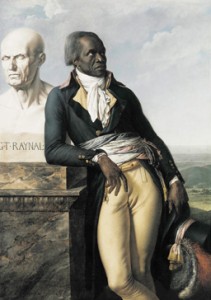Today we have another portrait to celebrate #fancyfriday, and that’s Anne-Louis Girodet-Trioson’s Portrait of Jean-Baptiste Belley!
Painted in 1797, the portrait aims to showcase Citizen Belley’s grandeur, a rare benefit from the tumultuous years of the French Revolution. Jean-Baptiste Belley was a former slave in the French colony of Saint-Domingue, better known today as Haiti. The Haitian Revolution in 1791

did away with most of the French colonial powers on the island and established a republic run by freed slaves. Elected in 1794, Belley began to campaign for the abolition of slavery in the French colonies as well as petitioned for full citizenship for people of African descent.
Girodet’s portrait aims to capture Belley’s easy grace. He places Belley leaning casually but alertly against a Romanesque bust of French thinker Raynal, who also staunchly against slavery. This Neoclassical framework allows Girodet to communicate the rational nature of his sitter, a highly prized quality in the new political regime. Belley is dressed in the incredibly #fancy typical clothing of a French soldier, staking his claim as just as important as the republican heads of state in France proper. The new regime’s core values of liberty, equality, and most importantly, fraternity are championed in Girodet’s portrait.
Belley’s expression is also rather telling. He looks as if he’s had about enough–of being looked down upon, of the French treating him as a subject rather than an equal, etc. His looking upward could also be seen as calling upon a higher power for justice—or reason, considering that this was painted during the atheistic age of reason established first by Robespierre. Whatever his reason for looking towards either the heavens or his own head, Belley has had quite enough of this injustice nonsense. With Raynal at his right hand—literally—Belley’s portrait calls out the inequality still present in the “rational” new republic. Through Girodet’s capturing of Belley’s casual elegance and rationality, we get a painting of exquisite quality and deep moral commitment.
Girodet’s portrait of Jean-Baptiste Belley not only captures the sitter’s #fancy outward appearance, but also hints at the rationality and morally upright nature of Citizen Belley. He’s truly a worthy candidate to add to our #fancyfriday pantheon!







